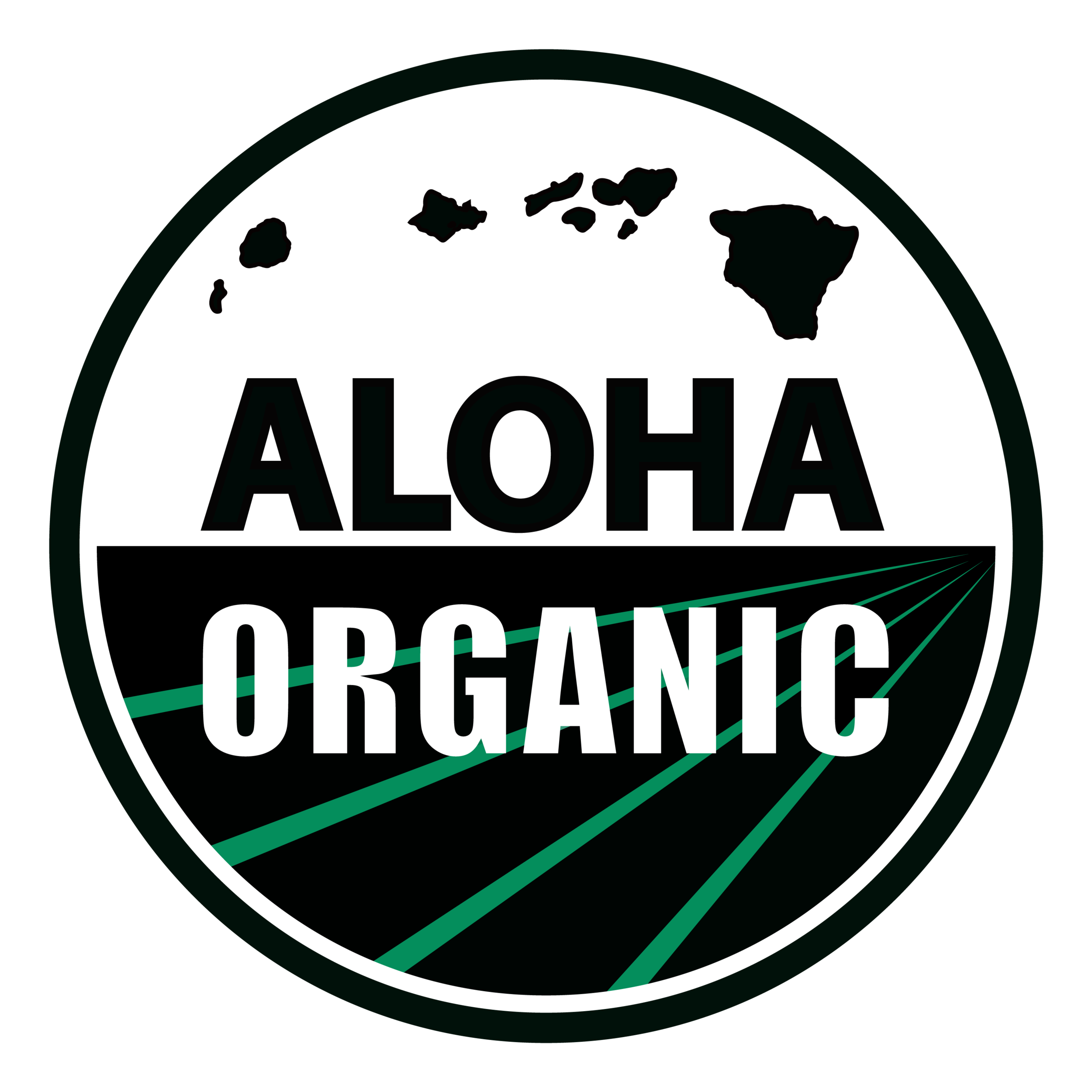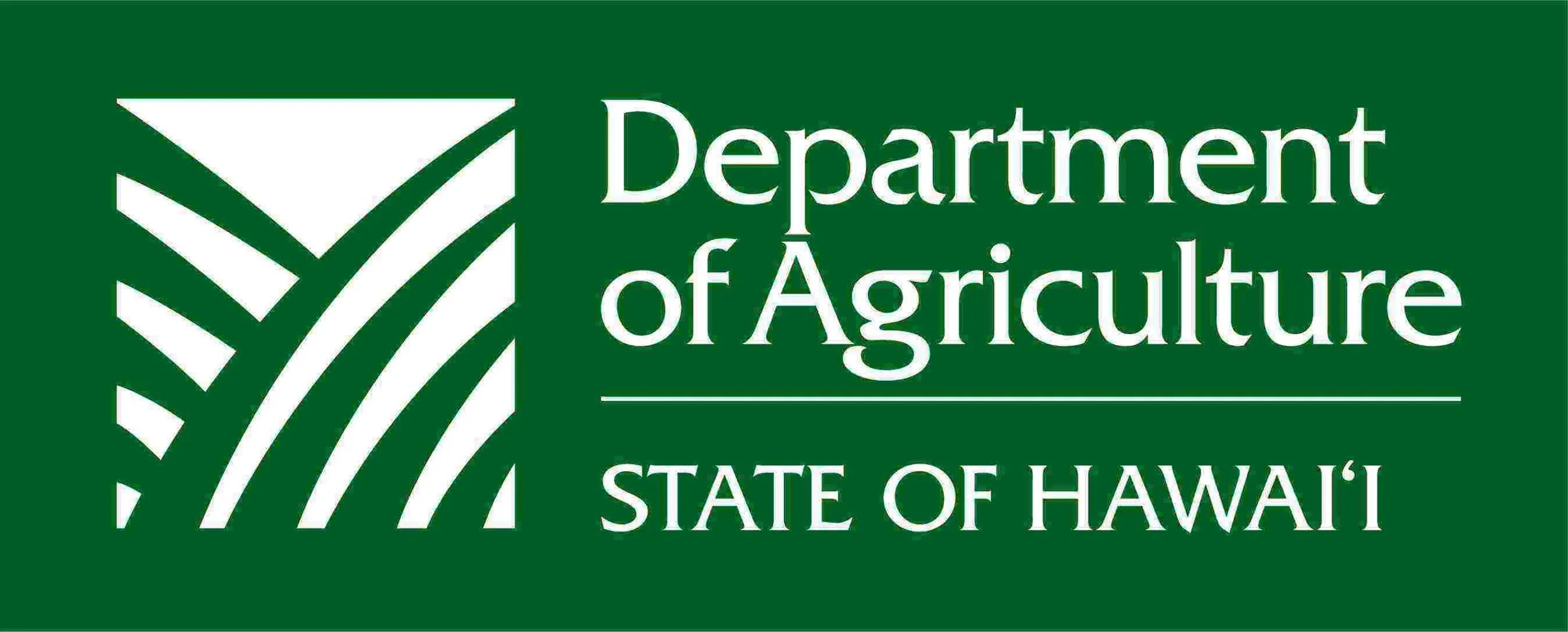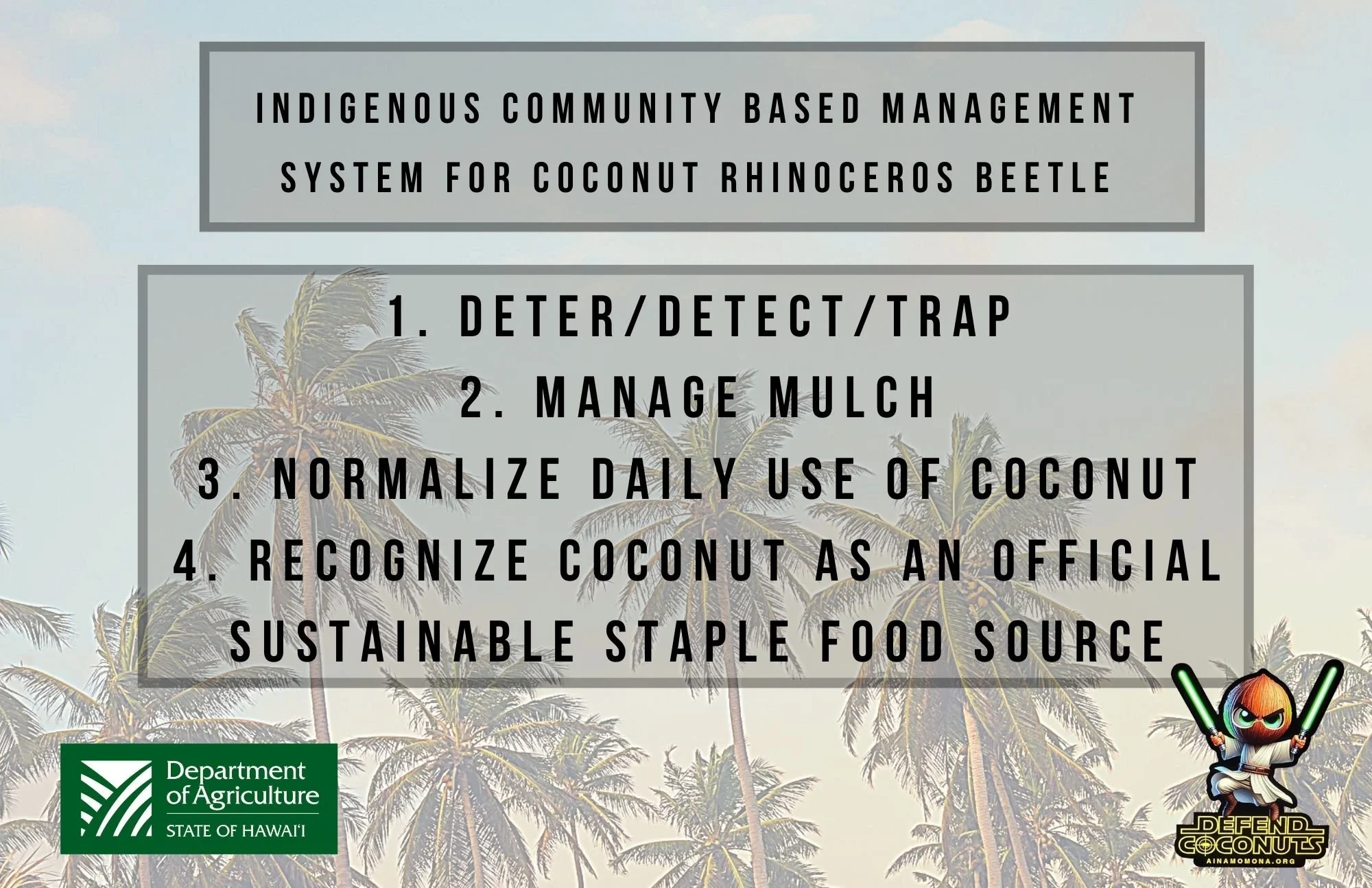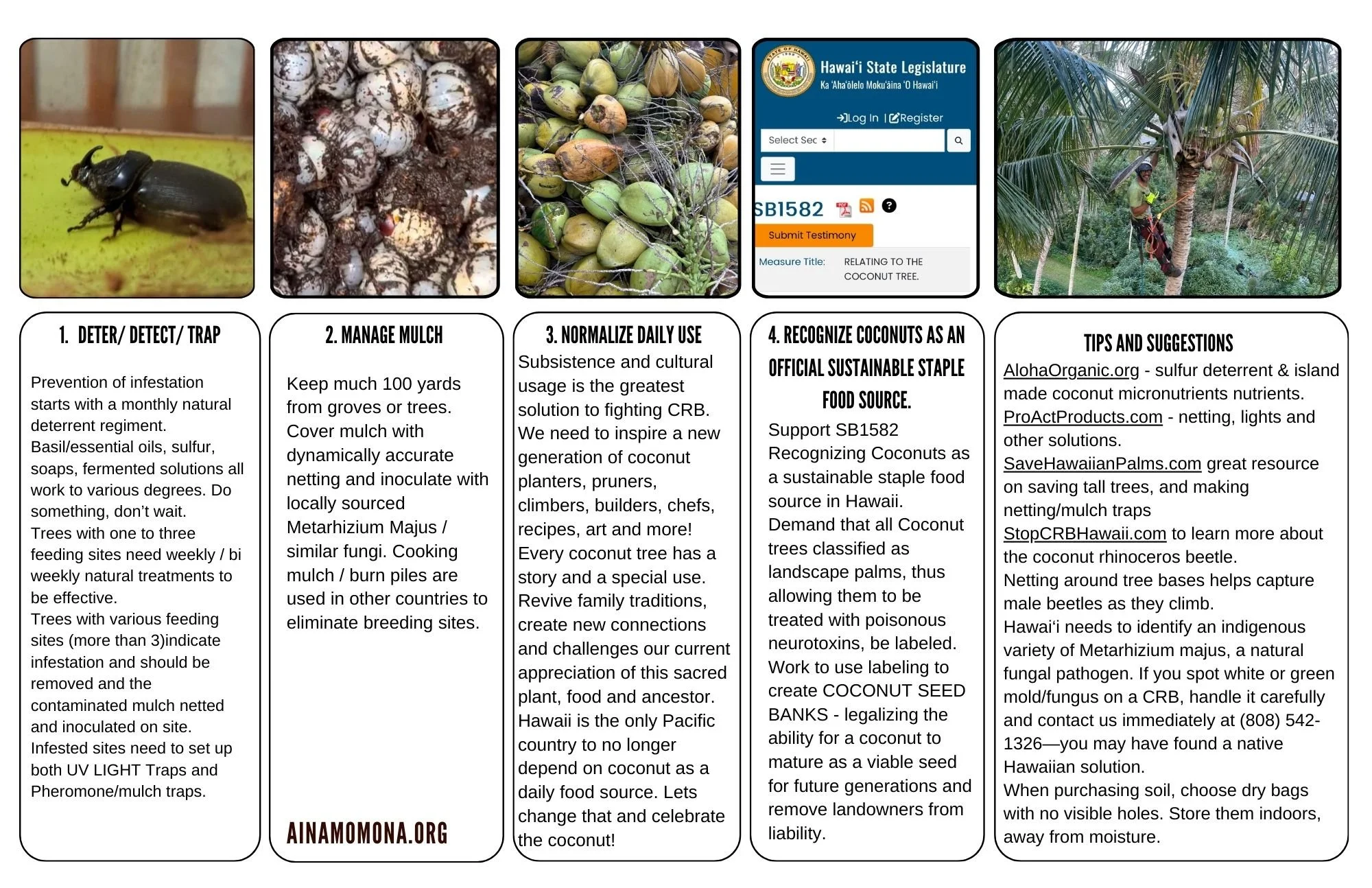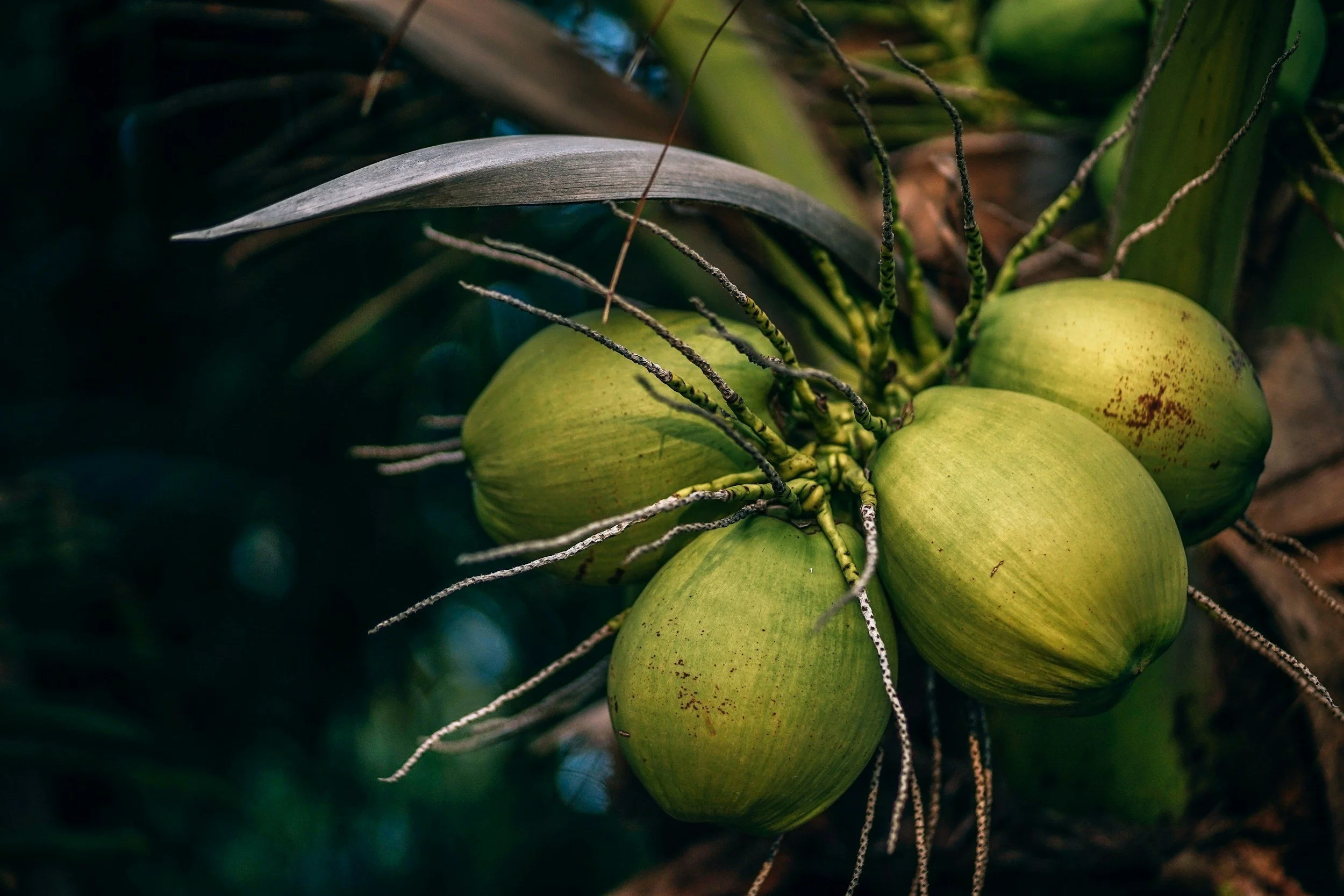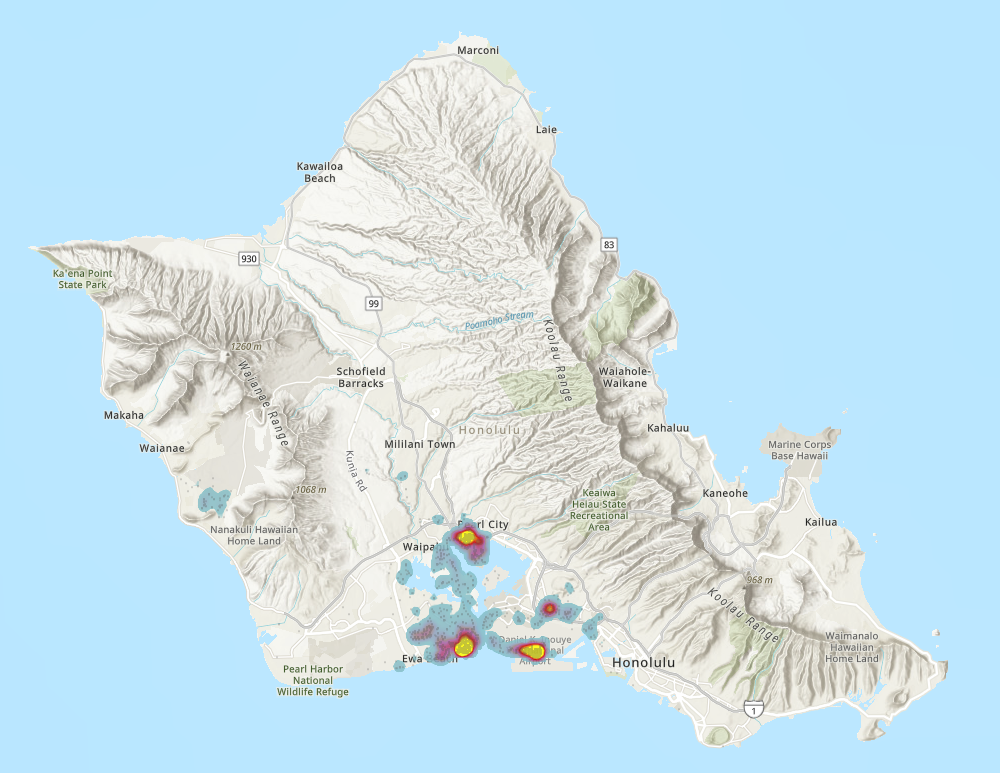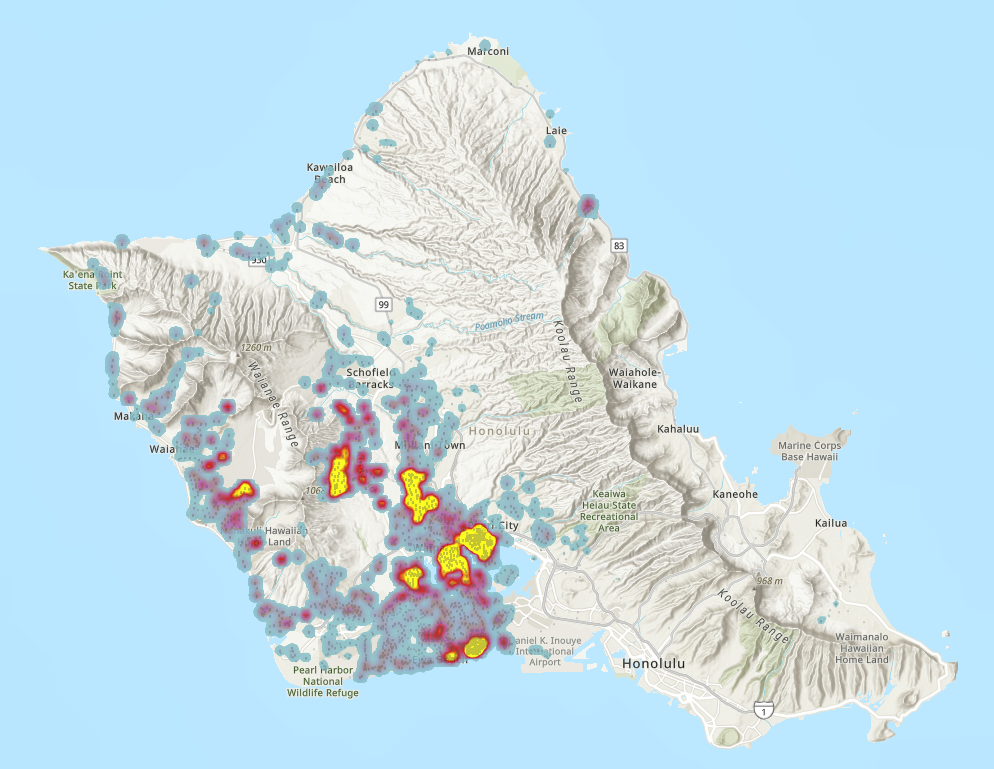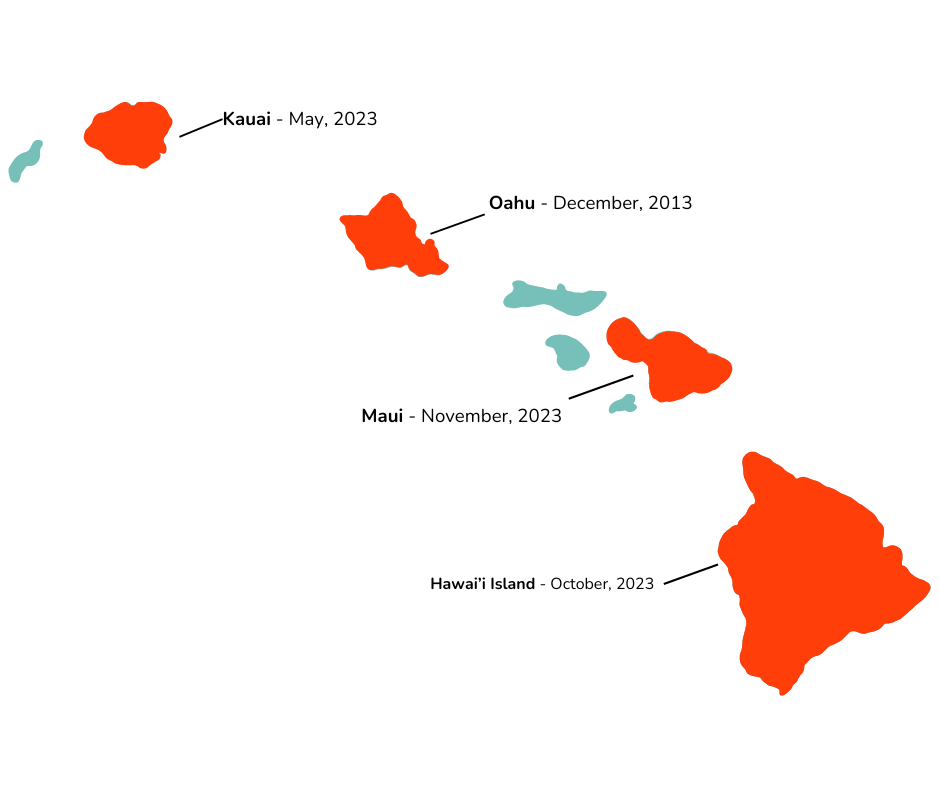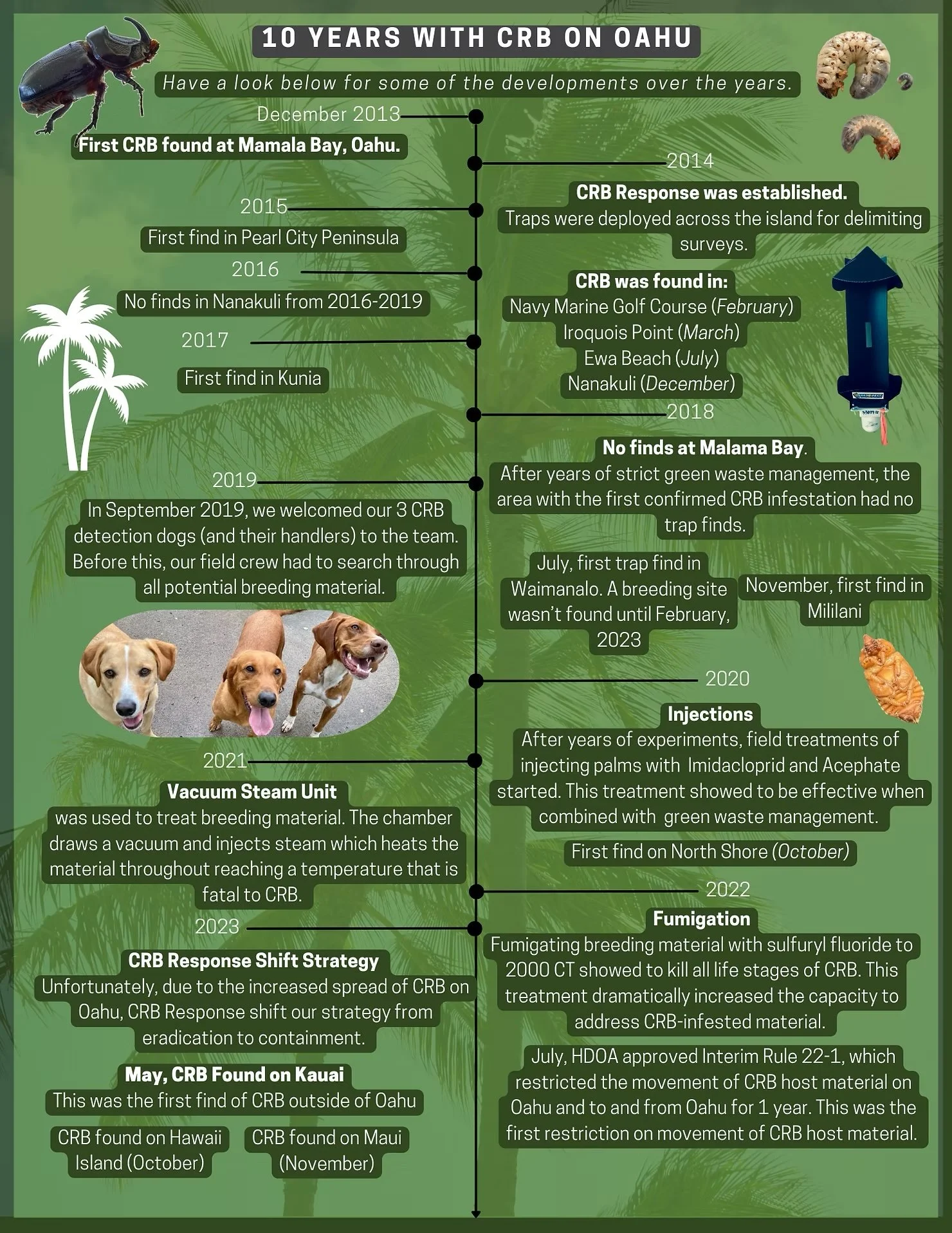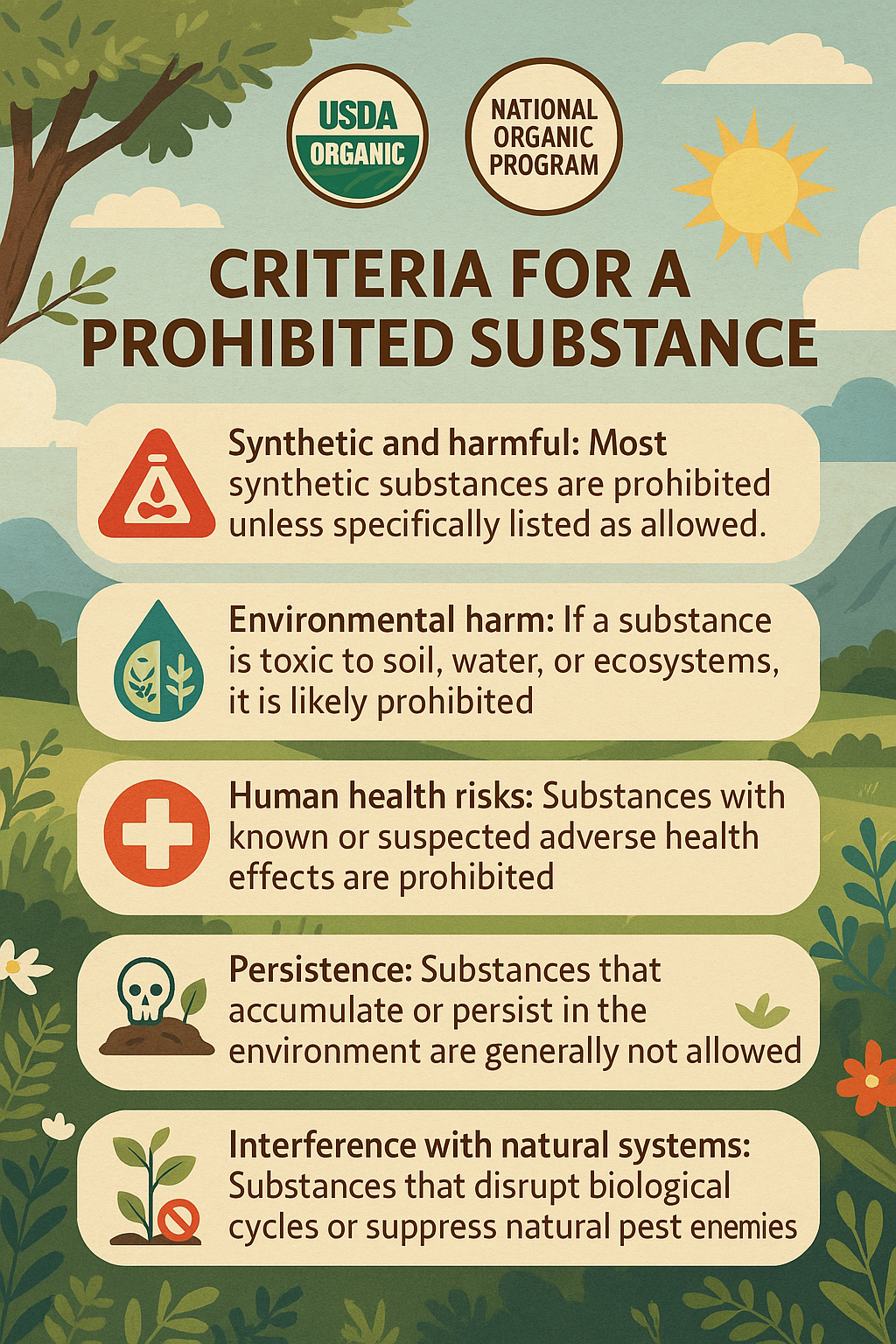HELP FIGHT CRB
The coconut rhinoceros beetle (*Oryctes rhinoceros*) is an invasive pest that poses a grave threat to Hawaii's iconic coconut palms and other tropical crops. Native to Southeast Asia, this beetle damages trees by boring into their crowns to feed on sap, which weakens the fronds and eventually kills the trees. Since its discovery in Hawaii in 2013 at Joint Base Pearl Harbor-Hickam, the beetle has spread across Oʻahu and Kauaʻi, jeopardizing not only the state’s agricultural economy but also its cultural heritage, as coconut palms hold deep significance for the Hawaiian people. The infestation is particularly concerning because the beetles can fly up to two miles and lay dozens of eggs in mulch and green waste, making containment a community-wide challenge.
Efforts to combat this destructive pest are ongoing, with state agencies, researchers, and local organizations working together to manage its spread. However, the infestation has already led to the removal of hundreds of infested coconut trees, raising fears that Hawaii could lose its palm and coconut trees entirely if control measures fail. The loss would not only alter Hawaii's landscapes but also impact its ecosystem and cultural identity. By integrating indigenous management systems which include: biological control, mechanical systems, labeling and other methods to deter, detect, and trap the beetles. Adding the integration of community action, and education around identification and sanitization protocols, Hawaii aims to protect its coconut palms and prevent further damage. Together, we can preserve these vital trees and ancestors for future generations.
Our Partners in the Fight! Mahalo!
SURVIVAL ESSENTIALS
Deter / Detect / Trap
Prevention of infestation starts with a monthly natural deterrent regiment. Basil/essential oils, sulfur, soaps, fermented solutions all work to various degrees. Do something, don't wait. Trees with one to three feeding sites need weekly / bi weekly natural treatments to be effective. Trees with various feeding Sites (more than 3)indicate infestation and should be removed and the contaminated mulch netted and inoculated on site. Infested sites need to set up both UV LIGHT Traps and Pheromone/mulch traps.
Mulch Management
Keep mulch 100 yards from groves or trees. Cover mulch with dynamically accurate netting and inoculate with locally sourced Metarhizium Majus /similar fungi. Cooking mulch / burn piles are used in other countries to eliminate breeding sites.
Normalize Daily Use
Subsistence and cultural usage is the greatest solution to fighting CRB. We need to inspire a new generation of coconut planters, pruners, climbers, builders, chefs, recipes, art and more! Every coconut tree has a story and a special use. Revive family traditions, create new connections and challenges our current appreciation of this sacred plant, food and ancestor. Hawaii is the only Pacific country to no longer depend on coconut as a daily food source. Lets change that and celebrate the coconut!
Recognize Coconuts as an Official Sustainable Staple Food Source
Support SB1582 Recognizing Coconuts as a sustainable staple food source in Hawaii. Demand that all Coconut trees classified as landscape palms, thus allowing them to be treated with poisonous neurotoxins, be labeled. Work to use labeling to create COCONUT SEED BANKS - legalizing the ability for a coconut to mature as a viable seed for future generations and remove landowners from liability.
AFFECTED AREAS
CRB trap catches between 2014-2018
CRB trap catches between 2019-2022
Detection Dates by Island
CRB Timeline
Map Images and Timeline courtesy of CRBHawaii
THEIR “SOLUTIONS” (from for-profit corporations, chemical company partners and politicians)
100% OF PEOPLE ARE ALLERGIC •DESTROYS SOIL HEALTH • INCREASES POLLUTION • POISONS WATER • REDUCES BIODIVERSITY •ERODES ECOSYSTEM HEALTH •CREATES IMBALANCE •DAMAGES RESOURCES •SO FAR DOES NOT WORK • IS TOXIC POISON
IMIDACLOPRID
PROHIBITED SUBSTANCE! [USDA AMS List of Allowed and Prohibited Substances]
HARM TO BEES: Decreases honey bee survival rate and adversely affects crop pollination of food and native Hawaiian crops [PubMed Central Study]
CONTAMINATION OF WATERWAYS: Detected in surface waters of Hawaii and is toxic to ecosystems and human health [Stream Pesticide Levels on Oahu and Kauai]
TOXIC TO AQUATIC INVERTEBRATES: EPA Declares highly toxix to aquatic invertebrates, which are curcial components of Hawaii’s freshwater ecosystems [EPA Study]
PERSISTENCE IN SOIL: Has a prolonged half-life in soil, leading to extended periods of environmental exposure. This increases the likelihood of affecting groundwater and non-target organisms.
RISK TO ENDANGERED SPECIES: The U.S. Environmental Protection Agency has concluded that imidacloprid is likely to adversely affect a significant percentage of federally listed endangered or threatened species and their critical habitats, some of which are found in Hawaii.
RESIDUES IN AGRICULTURAL PRODUCTS: The use of imidacloprid in agriculture can lead to residues in crops, potentially affecting human health and leading to trade restrictions for Hawaiian produce.
IMPACT ON NON-TARGET INSECTS: Beyond bees, imidacloprid can negatively affect other beneficial insects, such as natural predators of pests, potentially leading to pest resurgence and imbalances in Hawaii's ecosystems.
PYRETHROIDS
PROHIBITED SUBSTANCE! [USDA AMS List of Allowed and Prohibited Substances]
TOXICITY TO AQUATIC LIFE: Pyrethroids are highly toxic to aquatic organisms, including fish and invertebrates.
CONTAMINATION OF SURFACE WATERS: Studies have detected pyrethroid pesticides in surface waters downstream of agricultural and developed lands in Hawaii. [USGS Pesticides in Surface Water]
IMPACT ON HONEY BEES: Exposure to sublethal doses of pyrethroids can alter honey bee behaviors, such as movement and social interaction, potentially affecting pollination activities crucial to Hawaii's agriculture. [Entomology Today. Altered Honey Bee Behavior]
PERSISTENCE IN THE ENVIRONMENT: Pyrethroids tend to bind tightly to soil particles, leading to prolonged environmental persistence. This characteristic increases the risk of long-term exposure to non-target organisms in Hawaii's diverse habitats.
POTENTIAL SYNERGISTIC EFFECTS: Interactions between pyrethroid exposure and viral infections may exacerbate adverse effects on honey bee health, contributing to colony declines. [PubMed. Understanding Drivers of Bee Declines]
RISK TO ENDANGERED SPECIES: The Environmental Protection Agency has identified potential risks of pyrethroids to endangered species.
OUR ORGANIC SOLUTION (from a non-profit, run by indigenous, local, farmers and scientists)
100% USDA ORGANIC COMPLIANT •IMPROVES SOIL HEALTH • REDUCES POLLUTION • CONSERVES WATER • SUPPORTS BIODIVERSITY •BOLSTERS ECOSYSTEM HEALTH •ENHANCES BALANCE •CYCLES RESOURCES •WORKS!!!
ARMOR +
SULFUR SOLUTION + FULL TREE HEALTH SET
The USDA organic regulations describe organic agriculture as the application of a set of cultural, biological, and mechanical practices that support the cycling of on-farm resources, promote ecological balance, and conserve biodiversity. These include maintaining or enhancing soil and water quality; conserving wetlands, woodlands, and wildlife; and avoiding use of synthetic fertilizers, sewage sludge, irradiation, and genetic engineering.
Organic producers use natural processes and materials when developing farming systems—these contribute to soil, crop and livestock nutrition, pest and weed management, attainment of production goals, and conservation of biological diversity.
This factsheet provides an overview of some common practices that organic producers and handlers use to ensure organic integrity and operation sustainability.
THE BOTTOM LINE
Sulfur is a naturally occurring element that meets all the National Organic Program (NOP) criteria. It's safe, effective, and has been trusted in organic farming for decades. Its long-standing use reflects its ability to support plant health without compromising human safety, ecological balance, or long-term sustainability.
In contrast, the synthetic chemicals being proposed are prohibited or restricted for good reason:
They are known to cause permanent damage to ecosystems, harm to animals, long-term health risks to humans, and contamination of vital resources like soil and water.
This isn’t innovation. It’s destruction disguised as progress.
We need practices rooted in regeneration, responsibility, and respect.
(Aloha) Organic farming isn’t just a preference—it’s a commitment to life.
A commitment to future generations, clean food, and a planet that can keep growing it.
